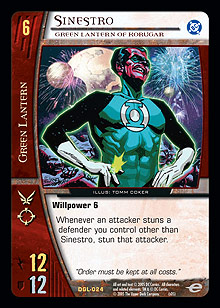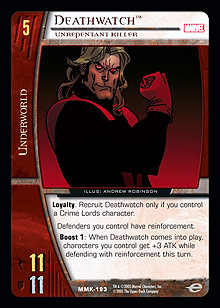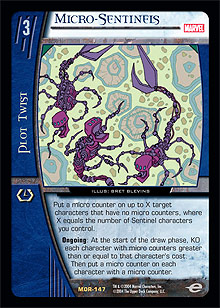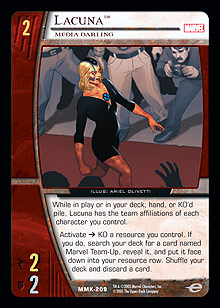
Hello. After last week’s special edition, I figured I’d better answer some reader questions this week. Otherwise, some of you might wait a month to see your questions unveiled to an expectant public, and that just wouldn’t do.
Just so there’s no confusion (and in case, y’know, some of you want to plan your holidays around Cerebro publication dates, which is not unreasonable), Cerebro will return every two weeks from today. The alternate weeks may contain some Green Lantern draft action if and when the locals stop playtesting for constructed $10K events and actually do some drafting. But I digress.
Ronald R., from Manila, Philippines, asks this week’s featured question.
 Green Lantern is my favorite comic book in the whole world and one of my favorite cards right now is Sinestro, Green Lantern of Korugar. Let’s say I control Sinestro and Kilowog. If my opponent team attacks Kilowog with Spider-Man, Friendly Neighborhood Spider-Man and a bunch of Wild Packs, would Sinestro stun all the attackers after they stun Kilowog? Or would Spidey’s protection save them? It’s a hot topic right now in my playgroup. I say they stun because Sinestro’s effect triggers after the attack. Others say nothing will happen because Spidey and his friends lose the attacker characteristic after Kilowog gets stunned.
Green Lantern is my favorite comic book in the whole world and one of my favorite cards right now is Sinestro, Green Lantern of Korugar. Let’s say I control Sinestro and Kilowog. If my opponent team attacks Kilowog with Spider-Man, Friendly Neighborhood Spider-Man and a bunch of Wild Packs, would Sinestro stun all the attackers after they stun Kilowog? Or would Spidey’s protection save them? It’s a hot topic right now in my playgroup. I say they stun because Sinestro’s effect triggers after the attack. Others say nothing will happen because Spidey and his friends lose the attacker characteristic after Kilowog gets stunned.
You are correct! In your scenario, Sinestro triggers once for each team attacker that stuns Kilowog during attack conclusion. Those triggered effects are put on the chain after the attack concludes (and characters are no longer attacking). When those triggered effects resolve, the characters will be stunned because neither they nor Spidey are attacking at that time.
The characters need not be attackers on resolution of the triggered effects. The card text uses “stun that attacker” only to identify the character to be stunned from the earlier sentence.
Javen T., from Singapore, asks a question about each of the two most recent sets.
I control Arisia, Dr. Polaris, and Manhunter Lantern. I flip Hard-Traveling Heroes. In response, my opponent plays Yellow Impurity on Arisia. Is the effect of Hard-Traveling Heroes negated?
For ease of reference, Arisia (GL) has printed willpower 1, Dr. Polaris (EE) has printed willpower 2, and Manhunter Lantern (MH) has printed willpower 4.
The Hard-Traveling Heroes effect is not negated. If Arisia’s willpower is reduced below 1 by Yellow Impurity in response, you can choose only the EE and MH affiliations on resolution.
 I have Deathwatch teamed with X-Men and a Beast on the field. My opponent pays 3 endurance for Steppenwolf, causing my characters to lose reinforcement this turn. If Deathwatch is stunned and subsequently recovered in the middle of combat with, say, Children of the Atom, does Beast regain reinforcement since Deathwatch’s continuous modifier is turned on again? Just for confirmation, did Beast ever lose reinforcement in the first place, since Deathwatch continuously gives all my defenders reinforcement?
I have Deathwatch teamed with X-Men and a Beast on the field. My opponent pays 3 endurance for Steppenwolf, causing my characters to lose reinforcement this turn. If Deathwatch is stunned and subsequently recovered in the middle of combat with, say, Children of the Atom, does Beast regain reinforcement since Deathwatch’s continuous modifier is turned on again? Just for confirmation, did Beast ever lose reinforcement in the first place, since Deathwatch continuously gives all my defenders reinforcement?
Great questions. The answers are yes and yes. Here’s how it works:
Let’s assume that Deathwatch is face up when your opponent resolves Steppenwolf’s effect. On resolution, it creates a continuous modifier that interacts with Deathwatch’s continuous modifier. Neither depends on the other, so they are applied in timestamp order. Deathwatch’s timestamp is the latter of when he came into play or was last turned face up, so Deathwatch applies first, and then Steppenwolf. Consequently, Beast is not reinforced.
If Deathwatch is stunned and then recovered, the timestamp of his modifier resets to the last time he was turned face up. If he is recovered after Steppenwolf’s effect resolves, then the two modifiers will apply to Beast in the opposite order, so he is reinforced. (Note that your opponent could then play Steppenwolf’s effect a second time to remove reinforcement from Beast again).
Javen also wanted to get the lowdown on Anti-Green Lantern and Xallarap, as did Alex C., of Townsville, QLD, Australia, and Mark A., of indeterminate origin.
Are Anti-Green Lantern and Xallarap KO’d if they are stunned as the recovery phase starts?
No. If such a character is stunned as the recovery phase starts, its text is inactive so it has no power to trigger (and consequently won’t be KO’d).
Chris S., from the Philippines, stays on the theme of inactive text with questions about two keywords.
Does Ricochet’s power protect stunned characters with evasion (so my opponent cannot Quick Kill my stunned Dusk)? Does Superman, Blue’s power count stunned characters with the cosmic keyword?
The answer to both questions is no. The evasion and cosmic keywords both appear in a character’s text box, and a stunned character’s text box is inactive. Consequently, stunned characters cannot be “characters with evasion” or “characters with cosmic.”
 Maik S. asks some up-to-the-minute questions about the current Micro-Sentinels technology.
Maik S. asks some up-to-the-minute questions about the current Micro-Sentinels technology.
Micro-Sentinels has a threshold of 3, so its earliest KO effect will be turn 4, right? Is there a way I could trigger it so that it would have a KO effect on turn 3?
Not if you play it on turn 3, no. You could potentially use a card like Beast to allow you to play it on turn 2 (but please see previous disclaimers about my complete lack of deckbuilding Skillz).
Also, I would like to verify that I can add micro counters to characters at the start of the draw phase, even if I don’t KO any characters that turn.
That’s correct. You resolve the entire triggered effect, so even if the first part doesn’t do anything, the second part still can.
Kelvin B., from South Africa, takes up the baton and asks the second in a series of three questions about effect holism.
Here’s a question that just arose out of a tournament today. My unboosted Metron was attacking a defender when my opponent flipped Blown to Pieces. He controlled both a Crime Lords and an Underworld character. I responded by removing Metron’s cosmic counter to negate the effect. My opponent then tried to replace the Blown to Pieces, but I argued that the entire effect had been negated. Does Blown to Pieces count as one effect?
Yep, you’re correct. Blown to Pieces puts a single effect on the chain, and the entire effect is negated by Metron’s payment power.
Andrew enquires after the Lord of Latveria.
I control Hulk and Thing, The Ever-Lovin’ Blue-Eyed Thing, and then I recruit Dr. Doom, Lord of Latveria. Common Enemy is in play, so I control three Doom characters for his come-into-play effect. If I have two plot twists face up in my resource row (such as Signal Flare and Common Enemy), can I turn those two down, then flip one up again to use it, then turn it down again to account for the third resource of Doom’s effect? In other words, can I resolve a plot twist during his come-into-play effect?
Unfortunately, you can’t do what you’re suggesting.
When Doom comes into play, his triggered effect goes on the chain. You can, of course, respond to that triggered effect by playing plot twists from your resource row and/or flipping locations, but when it resolves, it resolves completely (like all effects).
In other words, when it resolves, you choose a number from 0 to X (where X is the number of Doom characters you control) and turn down that many face-up resources before either player gets priority to do anything else.
Ken W., from St. Petersburg, FL, USA, continues the theme of quick character questions.
If I equip Medusa with Armed Escort, does she still receive her effect when she becomes the defender?
If Medusa is equipped with Armed Escort and you activate her to use the Armed Escort power, Medusa’s power will indeed trigger on resolution of the Armed Escort effect (if you control a defender).
 Adam S., from Virginia, USA, explores the dire consequences of using Lacuna forgetfully.
Adam S., from Virginia, USA, explores the dire consequences of using Lacuna forgetfully.
What happens when you use Lacuna’s power but have no Marvel Team-Ups left in your deck?
When Lacuna’s effect resolves, you must KO a resource if you control at least one. If you do, shuffle your deck and discard a card. You may also look through your deck before shuffling, so it’s not all bad.
Just mostly bad.
Jason O. heads into X-territory . . .
Let’s say U-Go-Girl, Eddie Sawyer is attacked by my opponent’s Marvel Knights character, and then my opponent plays Bring the Pain. If there is another Marvel Knights character in play, can I discard an X-Statix character to redirect Bring the Pain to that character? Or is there a subtle targeting rule that prevents these types of plot twists from hitting characters not directly involved in combat?
Nope, that works fine. You need only select a new target “Marvel Knights character.”
If instead your opponent played something like Head Shot, for example, the new target would also have to be a “Marvel Knights attacker,” which would mean that U-Go-Girl’s effect could do nothing useful if there was only one attacker.
. . . Justin A. sets up X-camp there . . .
Say I play a boosted Vivisector, Lunatic Lycanthrope. Using his effect, I have my opponent exhaust his 6-drop. While Vivisector is in play (before he comes back to my hand), can I play Entangle, exhaust Vivisector, discard a card (to pay the cost of Entangle), target my opponent’s 4-drop with Entangle (exhausting it, as well), and bring the exhausted Vivisector back to my hand (leaving my opponent with 2 exhausted characters)? Is this legal?
Yep, it’s legal. I’ll just clarify the timing a little.
Your boosted Vivisector comes into play and his triggered effect goes on the chain if you control another X-Statix character. You target your opponent’s 6-drop.
In response to the triggered effect, you play Entangle targeting your opponent’s 4-drop, exhausting Vivisector and discarding a card as additional costs.
After successive passes, Entangle resolves, exhausting the 4-drop. After successive passes, Vivisector’s triggered effect resolves (if you still control another X-Statix character), exhausting the 6-drop if you choose and returning Vivisector to your hand.
 . . . And Martin L. does some X-reconnaissance.
. . . And Martin L. does some X-reconnaissance.
If I play a boosted Plazm on turn 6, can I X-Statix HQ him before he returns to my hand and still stun a character with DEF 10 or less?
Sure. As above, you may play the HQ effect in response to Plazm’s triggered effect. Note that Plazm will stay in your KO’d pile rather than return to your hand (since the modifier no longer applies to him after he changes zones).
In a slightly related question, is it possible for my opponent to pump DEF in the build phase to attempt to get around Plazm’s boost?
Yes. Although many DEF pumps are restricted to attack substeps, some can be played during the build phase (Skinner is an example that comes to mind). Plazm’s effect will be negated if the target has DEF greater than 10 on resolution.
Gabe V., from San Salvador, El Salvador, brings down the curtain with a (you guessed it!) continuous modifier interaction delight. If only he’d supplied a mailing address . . .
I’m playing Doom and Sinister Syndicate. If I play Marvel Team-Up on turn 2 and then choose Doom for Forced Allegiance on turn 3, will that make characters cards in my hand Doom/Syndicate but characters I control Doom only?
Well, character cards in your hand will definitely have both affiliations. The question is which affiliation(s) your characters in play will have. And the answer is both.
The key to understanding why is—as always—dependency. MTU depends on FA (because FA can change a non-Doom character into a Doom character), but FA does not depend on MTU (because MTU can’t change an unaffiliated character into an affiliated character or vice versa).
Dependent modifiers are applied after the modifiers they depend on. This means that FA is applied first, and then MTU, so your characters will have both affiliations.
You know the drill. Please keep those Vs. rules questions coming to vsrules@gmail.com.